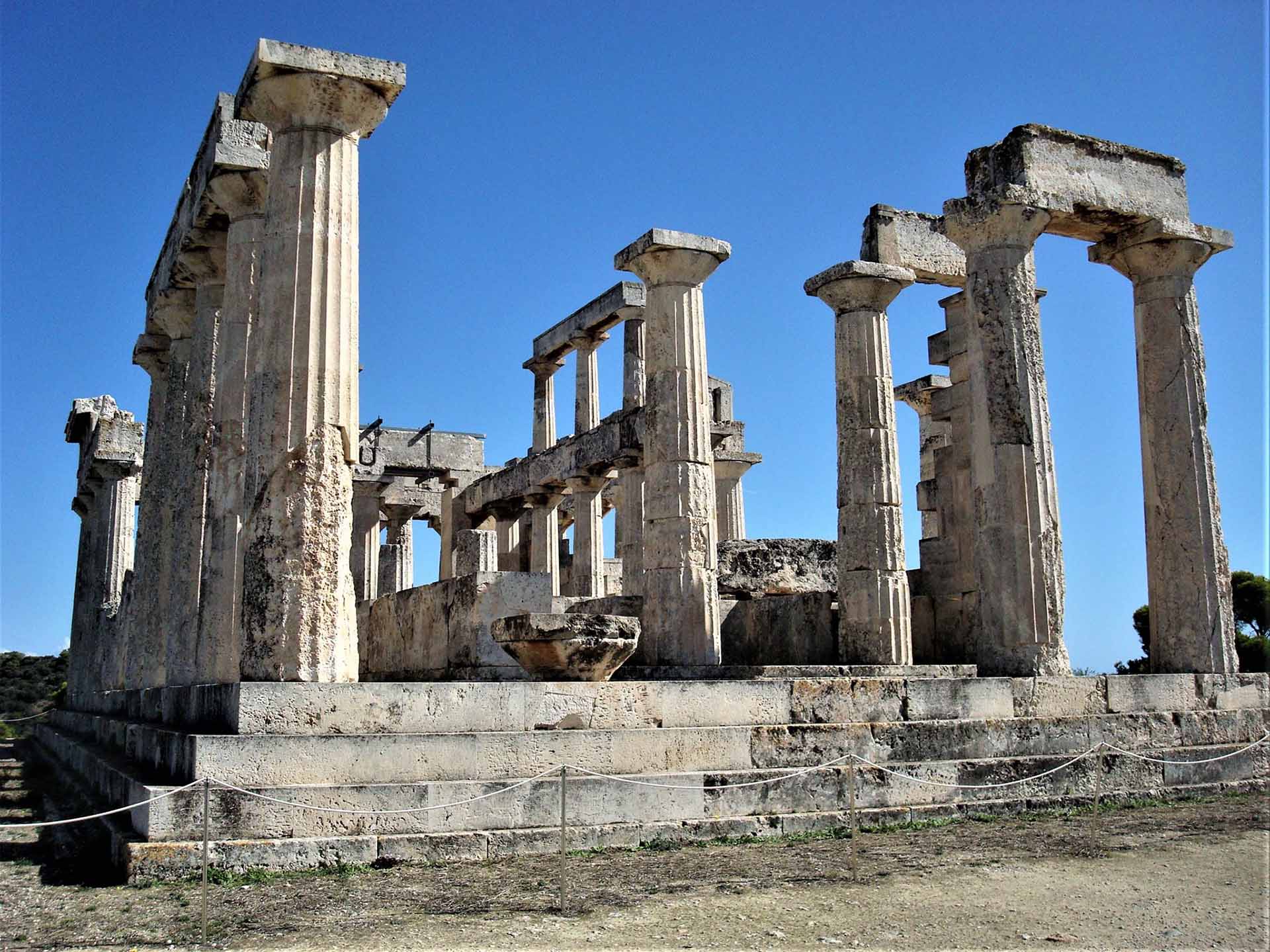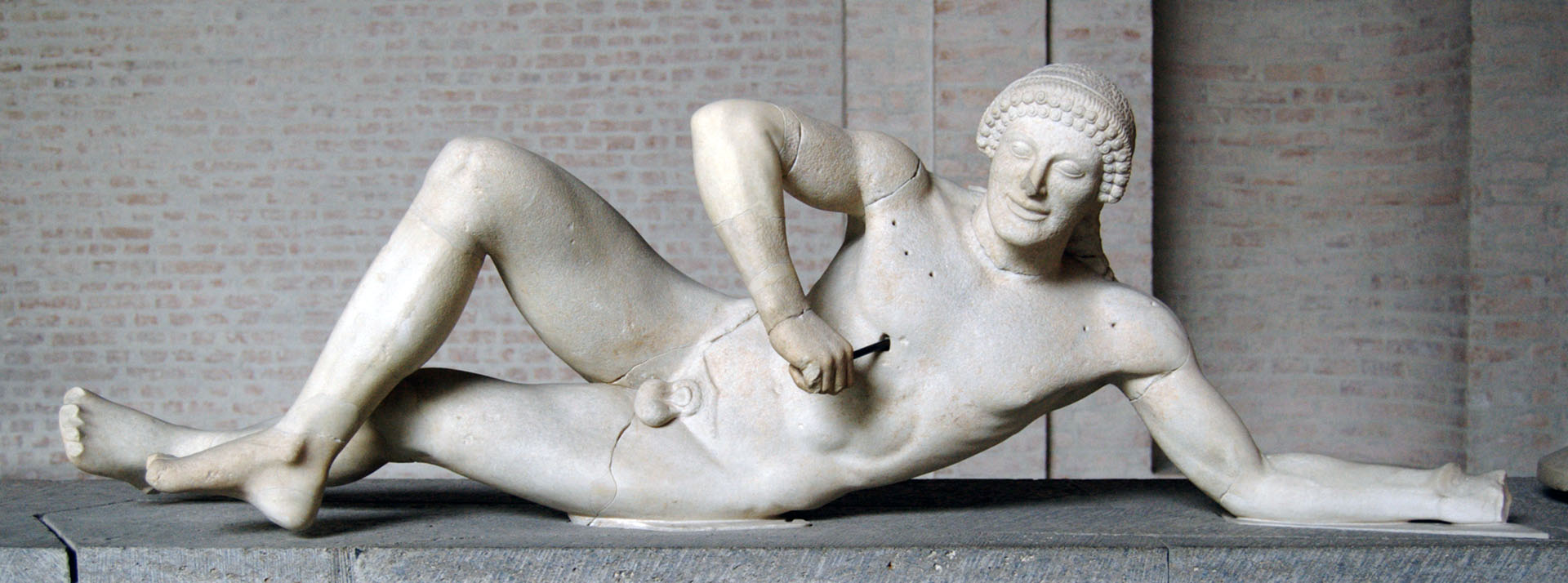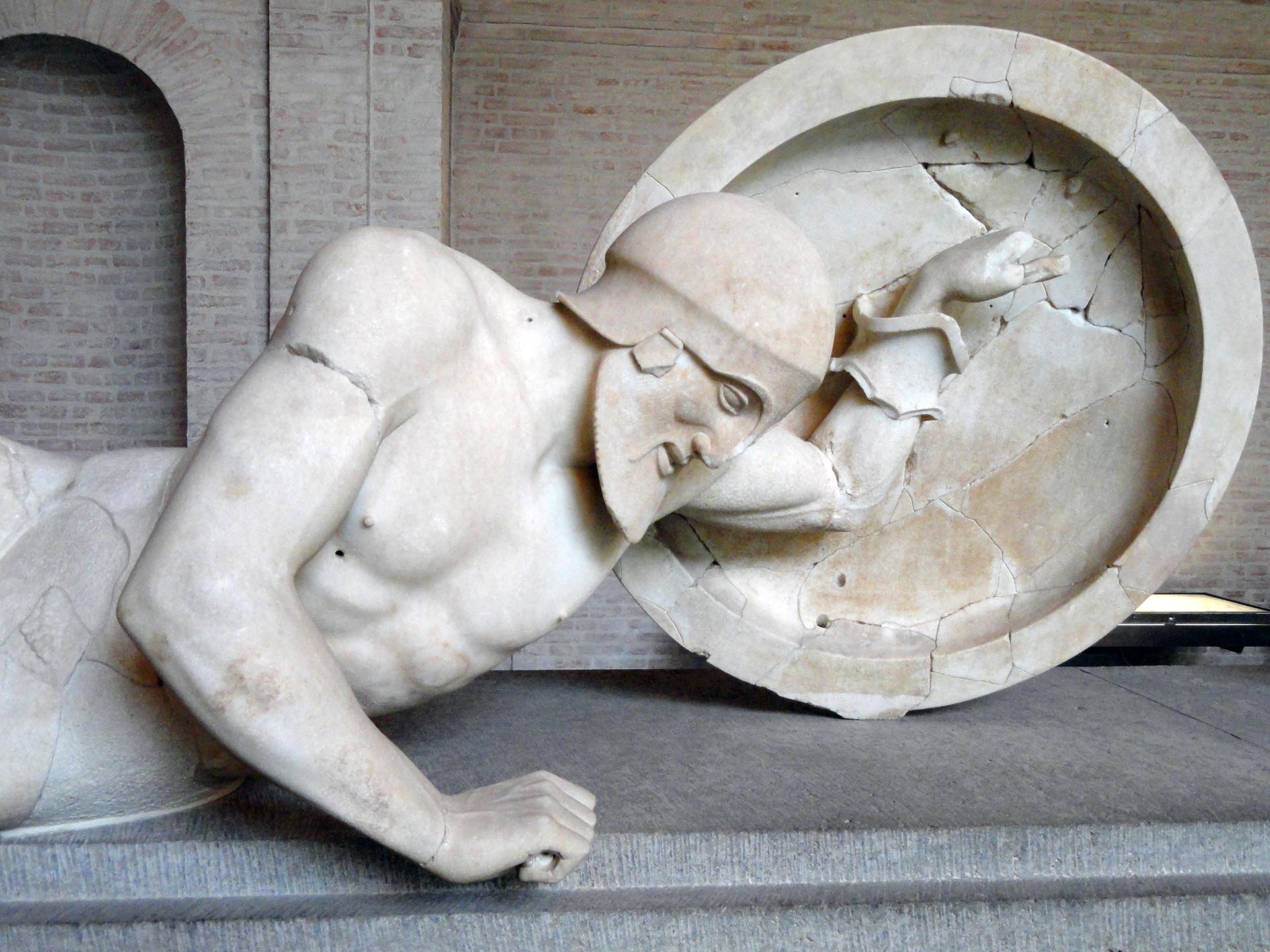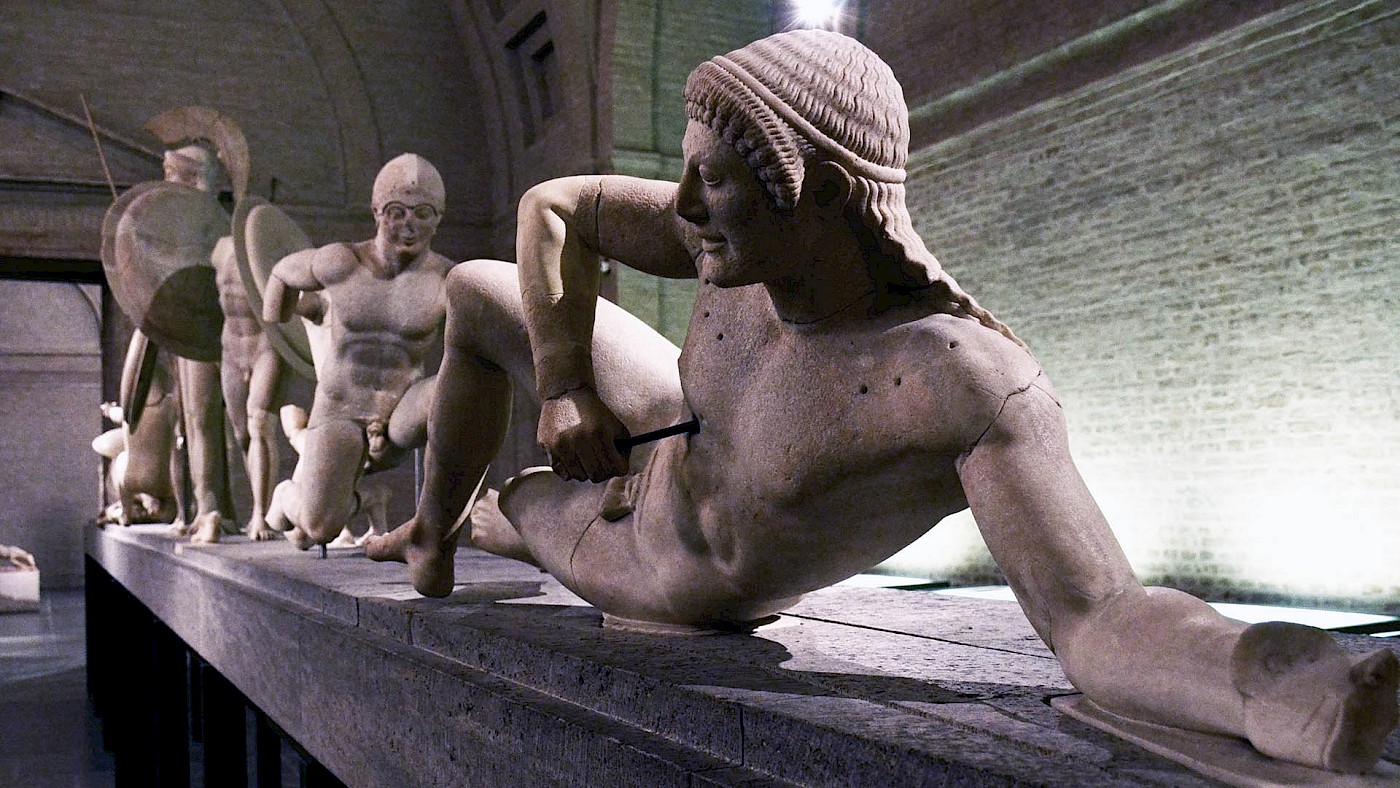The island of Aegina lies in the Saronic Gulf, just south and a little to the west of Salamis. Aegina’s maritime importance seems to extend at least as far back as the third millennium BC (Broodbank 2013, pp.332-333), and it was a great rival of Athens in the sixth century.
The mythological ancestry of is island is no less grand. The nymph Aegina, from whom the island was said to take its name, was raped by Zeus and gave birth to Aiakos, who became king of the island. Aiakos was the father of Peleus and Telamon and thus the grandfather of Achilles and Ajax. Both of these generations of heroes took part in a war against Troy – the elder led by Herakles, the younger, Agamemnon.
Each of these conflicts was depicted in the pediments of temple on Aegina dedicated to the goddess Aphaia, who is only known from this one temple. (Pausanias 2.30.3 suggests that she was the deified Britomaris, called Aphaia on Aegina and Diktynna on Crete; Barringer (2014, pp. 198-99) notes that the “votives suggest that she was worshipped as kourotrophos (nurse) by both men and women.”) The pedimental sculptures, like many others, were looted from Greece in the nineteenth century and now reside in the Glyptothek Museum in Munich, Germany.
The Temple
The Temple of Aphaia is assigned to the Doric order of architecture, and was constructed on the site of a sixth-century predecessor that was destroyed by fire. It is “rather small” at 13.77 × 28.82 m, with a 6 × 12 colonnade (Yeroulanou 2012).
The temple has been described as “a late archaic gem” (Stewart 2008b, p. 56), the point at which the Doric temple is standardized (Yeroulanou 2012). The 1:2 ratio of the colonnade (6 × 12) is repeated in the façade, with the height of the columns double the distance between their centre points. The thin columns, 3ft rather than 4, mean that the colonnade is more open than usual (Stewart 2008b, p. 56).

While the temple itself is constructed of the local limestone, which was coated in stucco to imitate marble, the roof tiles were ceramic and architectural sculpture was made of marble from Paros (Barringer 2014, pp. 198-200; Yeroulanou 2012). The metopes in the frieze were left blank.
The pediments
The sculptures from the Temple of Aphaia were excavated in 1811. After they were taken from Greece, they were bought by King Ludwig I of Bavaria who had the neo-Classical sculptor Bertel Thorvaldsen (1770-1844) “restore and improve” them (Boardman 1978, p. 156). These so-called improvements have since been removed.
Several scholars state that the battles depicted have been disputed, although I have seen no suggestions that they are anything other than two different sacks of Troy (Boardman 1978, p. 156; Barringer 2014, pp. 199-200). The west pediment depicts the “second” sack of Troy by the Achaeans led by Agamemnon; the east, a sack a generation earlier led by Herakles, identified by his lion-skin cap on the north side of the pediment, crouching, as an archer.

Andrew Stewart notes that in an Isthmian ode to the Aeginetan panakration victor Phylakidas, dated ca. 478 BC, Pindar mentions both of these sacks of Troy and the role of Aegina through Telamon, Peleus, Ajax, and Achilles, descendants of the nymph Aegina (Pindar, Isthmian 5.34-50). Stewart further suggests that Pindar links this role to the valour of the Aeginetans at the Battle of Salamis in 480 BC, which we will come to below (Stewart 2008b, p. 56).
Both pediments centre Athena. On the west pediment, symmetrical groups of decreasing size allow the action to decline in size down to crouching archers and a fallen warrior, lying down, into the corner. The east pediment, which is slightly less well-preserved, shows a greater variety of pose, including a “more active” Athena (Boardman 1978, p. 156); nevertheless, in the corner crouches Herakles the archer, and at both the north and south point lies a dying warrior.

The human figures on each side are three-quarter life-size (Barringer 2014, p. 200); Athena, the goddess, is of course slightly larger. Most of the human figures on both pediments are naked but for their helmets and shields; the exceptions are the archers. Herakles wears armour and his lion-skin cap; the archer on the west pediment wears a full body suit.
The body suit of this archer was once brightly painted in “Scythian”-Persian dress, indicating that he may be identified as Paris/Alexandros, the Trojan prince (Cohen 2012). Cohen also notes that this is the beginning of a post-Persian War change in Greek art, in which Trojans are no longer depicted in the same garb as their Greek enemies, but in Persianizing dress.
Whether Paris or another Trojan, the archer wears a body suit of many bright colours. While polychromy is universal in Greek sculpture, the Aphaia pediments are unusual in that they are painted entirely in the round, even though the backs of pedimental sculptures would not have been visible (Palagia 2012).
Archaic or Classical?
For anyone familiar with the pediments of the Temple of Aphaia from scholarship before the twenty-first century, some of the comments above may seem a little unusual. The association with Pindar’s ode and the suggestion that the “Scythian” archer reflects a post-Persian War trend both point to a date for these sculptures after 480 BC.
In the 1970s, John Boardman wrote, “The east pediment seems marginally later in style and more advanced in composition than the west. […] In some ways the contrast between the two is the contrast between the Archaic and the immanent Classical, yet little more than ten years may separate them” (Boardman 1978, p. 156). Boardman’s interpretation, that the west pediment dates ca. 500-490 BC and the east ca. 490-480 BC, was the commonly held one until fairly recently.
The argument once held that the second Temple of Aphaia was constructed in the late sixth century, but that the disruption of the Persian Wars led to a delay in the construction of the pediments. An earlier east pediment, partially completed but never installed, was identified among the remains at the sanctuary.
The contrast between the two pediments of this temple reinforced several conceptions about Archaic and Classical Greek art. That a single building could have two sets of sculptures in drastically different styles was used to suggest that the onset of the so-called classical style was sudden and dramatic. The impetus for this change was the dramatic event that presaged this greatest period of Greek history: the Persian Wars.

Stewart, relying on the unpublished work of several other scholars, re-examined the evidence and Aegina to suggest that the second temple did not date to the end of the sixth century, but actually post-dated the Persian Wars entirely. Furthermore, he argued that the evidence suggests that the preceding temple was destroyed by the Persians, as so much of the superstructure is smashed to pieces (Stewart 2008a, p. 593).
The evidence, then, suggests that all of the Aphaia sculptures would date after the Persian Wars, suggesting that the Archaic style was much more persistent than was previously believed. Yet the response of scholars has not been to suggest a later break between styles, but rather that artistic developments are more sophisticated than one style succeeding another.
Mark D. Stansbury-O’Donnell, in his History of Greek Art, notes that the word classical is not one that the fifth-century Greeks used to describe their art: “we should be careful to recognize that there was no uniform standard that ruled art in this period.” (Stansbury-O’Donnell 2015, p. 239).
Judith M. Barringer, meanwhile, points out that the convention to begin the Classical Period at the end of the Persian Wars is modern, and “does not reflect the complexities of the period” (Barringer 2014, p. 189-190).
Indeed, the sense now is that the Aphaia pediments are contemporary, at least insofar as we can be precise about archaeological dates. Stewart references N. Escbach’s comment that the similarities between the pediments suggest two separate workshops in communication with one another, and argues that these workshops were contemporary, with one more conservative and another more progressive in style (Stewart 2008a, p. 596).
Contrasts between the works tend to emphasise the “progressive” elements of the east pediment versus the “conservative” elements of the west in terms of their closeness-to-life. Barringer notes that Herakles’ stance on the east pediment is far closer to the “necessities for an actual archer” than the “awkward balance” of Paris on the west (Barringer 2014, p. 200).

The most constant comparison between the pediments lies in the dying warriors in the southern corners of each pediment. Stewart contrast the “jagged assortment of limbs” of the west warrior with the “natural-looking” warrior of the east pediment, concluding that the former’s “agony [is] so insistently externalized that we feel little sympathy for him” while the latter sculptor gets “inside the warrior’s skin [and] he invites us to do so as well.” (Stewart 2008b, pp. 57-59).
Stansbury-O’Donnell focuses on the viewer’s engagement, noting that the downward facing head of the warrior from the east pediment would make eye contact with a visitor at the temple entrance (Stansbury-O’Donnell 2015, p. 239). It is this contact, rather than the anatomy of the figure, that he argues indicates a change to the “classical” style.
Stewart, meanwhile, goes further, identifying both warriors as Trojan and arguing that this sympathy is the mark of the classical period: “Uniquely in the ancient world, classical Greek artists could bestow such sympathy equally upon friend and foe” (Stewart 2008b, p. 59; the extent to which we agree with Stewart here may depend on one’s reading of the Mykonos relief amphora, see Josho’s article on the subject).
This conclusion, however, brings with it a complication. Cohen noted that the archer sometimes identified as Paris begins a trend in which Trojans are depicted as Persians (Cohen 2012). Stewart’s argument, however, would seem to align more with the interpretation of the Kleophrades Painter’s red-figure kalpis from Athens as a scene in which the Greeks found themselves identifying more with the Trojans in this moment. Is what we see on the Aphaia pediments a response to the Trojan War in light of the Persian War?
Commemorating the Persian War?
Barringer notes, as a word of caution, that “Works of art created around the time of the Persian Wars are notoriously difficult to date without external evidence” (Barringer 2014, p. 193). Nevertheless, Stewart makes numerous arguments that would connect the Temple of Aphaia directly to that conflict.
First of all, there is the evidence mentioned above that the previous temple was destroyed violently and that the second temple was constructed soon after 480 BC. That the Aeginetans would want to commemorate the Greek victory in that war is hinted at by Herodotos, who notes that the Aeginetans won the popular vote for the prize of valour at Salamis (Herodotos 8.93). Furthermore, Stewart argues that Aegina was “awash” in Persian loot that could have paid for the new temple (Stewart 2008a, p. 597; Herodotos 9.80-81). However, this raises the question why Herodotos does not mention a Persian assault on Aegina, nor the use of the loot to build the temple.
Then there are the responses to the Trojan War reflected in the pedimental sculpture, Pindar’s ode to Phylakidas, and the decision to fetch the images of Aiakos and the Aiakidai from Aegina, and those of Telamon and Ajax from Salamis to the Greek fleet before the Battle of Salamis (Herodotos 8.64). Stewart suggests that this was part of a wider scheme connecting themselves to mythological glories at Troy, to Zeus through their mythical genealogy, and to their success in the Persian Wars (Stewart 2008a, p. 597; 2008b, pp. 56-57).
The connection between the Trojan War and the Persian Wars is not without precedent, as I have argued elsewhere. But it is also not the only possible meaning behind these choices of sculptural theme.
Barringer does not see a need to connect the celebration of Aeginetan heroes to the Persian Wars. Aegina suffered from “perpetual and recent trouble” with Athens, and celebrating their own mythical history would not be unusual in this context (Barringer 2014, pp. 200-201). In conclusion, she also notes that in 431 BC, when the Athenians seized the island, evicted the inhabitants, and settled their own people there, they appear to have replaced the cult image of Aphaia with that of Athena.
Concluding thoughts
New evidence, or reassessments of old evidence, should prompt archaeologists and ancient historians to look again at the old ideas and reassess them to realise something new and more interesting. The re-dating of the Temple of Aphaia at Aegina is a fine example of what can be gained by doing so.
Firstly, we can re-examine our old ideas about art historical periodization – how we divide up Greek art into different chronological periods. The new dates for the Aegina pediments remind us that stylistic change is not just an evolution of artistic expression toward naturalism, but conscious choices made by craftspeople to experiment and try new things or to align with styles already in place. It also reminds us that the choice is not always one-or-the-other – a sculptor can be conservative in the pose of their archer, and radical in their depiction of a Trojan in Persianizing dress.
Secondly, it allows us to reassess our ideas about the impact of historical events on cultural expressions such as sculpture. The Persian Wars were once seen as a turning point in Greek art from the “Archaic” to the “Classical”, but it is now clear that we cannot be so direct.
Yet this does not mean that the Persian War had no impact on art; it is possible to argue that it had a great impact on the Temple of Aphaia. However, we must also be alert to the fact that history is always occurring, and the temple may relate more to on-going concerns in Aeginetan/Athenian relations.
What we must certainly recognize is that there is always something interesting in stylistic change, and that something is rarely about closeness to reality. The motivations behind it, the choices craftspeople make, have meaning. If we are fortunate, perhaps we can have some insight into what.
Further reading
- Judith M. Barringer, The Art and Archaeology of Ancient Greece (2014).
- John Boardman, Greek Sculpture. The Archaic Period (1978).
- Cyprian Broodbank, The Making of the Middle Sea: A History of the Mediterranean from the Beginning to the Emergence of the Classical World (2013).
- Beth Cohen, “The non-Greek in Greek art”, in: Tyler Jo Smith and Dimitris Plantzos (eds), A Companion to Greek Art (2012), pp. 456-479.
- Olga Palagia, “Architectural sculpture”, in: Tyler Jo Smith and Dimitris Plantzos (eds), A Companion to Greek Art (2012), pp. 153-170.
- Mark D. Stansbury-O’Donnell, A History of Greek Art (2015).
- Andrew Stewart, “The Persian and Carthaginian invasions of 480 BCE and the beginning of the Classical style; Part 2, the finds from other sites in Athens, Attica, elsewhere in Greece, and on Sicily; Part 3, the Severe Style: motivations and meaning”, American Journal of Archaeology 112.4 (2008a): pp. 581-615.
- Andrew Stewart, Classical Greece and the Birth of Western Art (2008b).
- Marina Yeroulanou, “Architecture in City and Sanctuary”, in: Tyler Jo Smith and Dimitris Plantzos (eds), A Companion to Greek Art (2012), pp. 132-152.
